|
|
 |
 |
|
ADAPTIVE TECHNOLOGY is equipment designed to assist blind or
vision impaired people to read, write or access electronic information sources. Adaptive Technology (also sometimes called Assistive Technology) can take many forms. It can be software or hardware-based, utilise
mainstream computer technology or be completely stand-alone. The technology generally works on the basis of providing access via magnification, speech output, or presentation as braille.
Given below is a brief description of the general types of
adaptive technology in use. For more information contact the Association for the Blind of WA.
|
 |
 |
 |
|
 Braille Embossers Braille Embossers
Braille embossers are devices
designed to produce braille on paper. They can be as simple as manual, braille typewriter-like devices such as the Perkins Brailler, more advanced computerised memory-brailling devices
such as the Mountbatten Brailler or high speed computer braille  "printers" capable of producing many
pages of braille per minute. "printers" capable of producing many
pages of braille per minute.
Common brands of braille embosser
include the Everest, Versapoint, Thiel, ET, Romeo, Thomas, Bookmaker and Braille Express embossers. Braille Embossers vary in price depending on their method of operation and intended use.
|
|
|
 Large Monitors Large Monitors
Some people have vision impairments which
only require minor magnification. If this is the case, a larger than standard computer monitor may be all 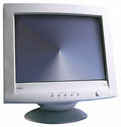 that an individual needs in order to use a computer. that an individual needs in order to use a computer.
Standard monitors are 14 or 15 inches
(measured diagonally across the screen). Larger monitors come in 17, 19, 20 or 21inch sizes. Common brands in use include Viewsonic, Samsung, Sony, NEC and many others.
|
|
|
 Palmtop Computers Designed for use by Blind People Palmtop Computers Designed for use by Blind People
With either QWERTY or braille-input
keyboards and inbuilt speech output or braille displays, these palmtop or laptop devices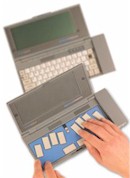 are designed specifically for use by blind and vision impaired people. Common features include word processing, diary and telephone directory,
database and communications functions, and the ability to connect peripheral devices such as printers, modems and braille embossers. are designed specifically for use by blind and vision impaired people. Common features include word processing, diary and telephone directory,
database and communications functions, and the ability to connect peripheral devices such as printers, modems and braille embossers.
Popular palmtops of this type include the
Aria, Keynote and Braille Companion, Braille Lite, Braille 'n Speak, Type 'n Speak, Braille Pad, Sqwert and BrailleNote.
|
|
|
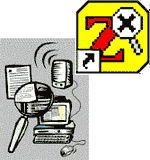 Screen Magnification Software Screen Magnification Software
Screen Magnification software enlarges
screen text and graphics to a size that a vision impaired user can easily view. Images can be enlarged anywhere between 2x to 20x their original size.
Programs are available for DOS, Windows
3.1, Windows 95/98, Windows NT, WIndows 2000 and Macintosh operating systems, and common examples include Zoomtext, InLarge, Magic, Magnum Deluxe and Luna.
|
|
|
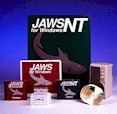 Screen Review Software Screen Review Software
Screen Reviews are computer programs
designed to send the text displayed on a computer screen to a speech synthesiser for output as spoken word. Screen Review software allows a blind computer user to have the  contents of the screen "described" to them as they use other mainstream computer applications. contents of the screen "described" to them as they use other mainstream computer applications.
Some of the common Screen Review programs
in use are JAWS, WindowEyes, ScreenPower, OutSpoken and Slimware Window Bridge.
|
|
|
 Speech Synthesisers Speech Synthesisers
Speech synthesisers, used in conjunction
with Screen Review software, provide spoken word output for personal computers. Speech Synthesisers can output most text as clear, near-human speech. Software synthesisers use the computer's soundcard
and speakers to produce speech, and hardware synthesisers are separate devices which plug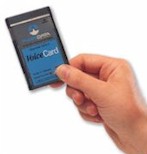 into the computer via a serial port, PCMCIA interface or as an actual slot-in card. into the computer via a serial port, PCMCIA interface or as an actual slot-in card.
Common software synthesisers include
the Dectalk Access 32, Eloquence and Flextalk.. Common hardware synthesisers include the Dectalk Express, Keynote Gold, Keynote Gold VoiceCard, Qtalk and DoubleTalk.
|
|
|
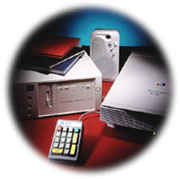 Text to Speech Scanners Text to Speech Scanners
These devices use a scanner, optical
character recognition software and speech synthesiser to reproduce printed text as spoken words in one simple step. A user can place a printed document on the scanner and press a button to have the document
spoken back to them immediately. Text to Speech scanner systems are easy to use, and becoming increasingly inexpensive as they begin to utilise PCs for their operations. inexpensive as they begin to utilise PCs for their operations.
Common Text to Speech scanning systems in use include the Robotron
Galileo, Kurzweil Omni 1000, Arkenstone Open Book, Robotron Rainbow and Aladdin Ambassador.
|
|
|
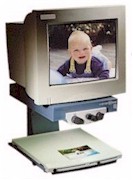 Video Magnifiers Video Magnifiers
Also known as Closed Circuit Television or CCTV's, these devices use a camera to magnify printed text and images. These are
then presented many times enlarged on a screen or monitor.
CCTV's vary greatly in price depending on the features available in each system. Popular
models of CCTV include the Clearview, Aladdin, Smartview, TVi, Eschenbach, Eezee Reader and Reinecker ranges.
|
|
|
 Other Types of Equipment Other Types of Equipment
There are many other devices designed to meet the literacy and information access needs of blind and vision impaired people.
 Devices such as Talking Scientific Calculators, Text-to-Braille Translation Software, Tactile Image Makers,
Talking Diary/Address Books, and Talking Dictionaries are all available in a number of different product ranges and prices. Devices such as Talking Scientific Calculators, Text-to-Braille Translation Software, Tactile Image Makers,
Talking Diary/Address Books, and Talking Dictionaries are all available in a number of different product ranges and prices.
|
 |
|
|

 Braille Displays
Braille Displays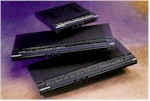 Braille Displays are excellent computer
access devices for braille literate people but are very expensive.
Braille Displays are excellent computer
access devices for braille literate people but are very expensive. Braille Embossers
Braille Embossers "printers" capable of producing many
pages of braille per minute.
"printers" capable of producing many
pages of braille per minute. Large Monitors
Large Monitors that an individual needs in order to use a computer.
that an individual needs in order to use a computer. Palmtop Computers Designed for use by Blind People
Palmtop Computers Designed for use by Blind People are designed specifically for use by blind and vision impaired people. Common features include word processing, diary and telephone directory,
database and communications functions, and the ability to connect peripheral devices such as printers, modems and braille embossers.
are designed specifically for use by blind and vision impaired people. Common features include word processing, diary and telephone directory,
database and communications functions, and the ability to connect peripheral devices such as printers, modems and braille embossers. Screen Magnification Software
Screen Magnification Software Screen Review Software
Screen Review Software contents of the screen "described" to them as they use other mainstream computer applications.
contents of the screen "described" to them as they use other mainstream computer applications. Speech Synthesisers
Speech Synthesisers into the computer via a serial port, PCMCIA interface or as an actual slot-in card.
into the computer via a serial port, PCMCIA interface or as an actual slot-in card. Text to Speech Scanners
Text to Speech Scanners inexpensive as they begin to utilise PCs for their operations.
inexpensive as they begin to utilise PCs for their operations. Video Magnifiers
Video Magnifiers Other Types of Equipment
Other Types of Equipment Devices such as Talking Scientific Calculators, Text-to-Braille Translation Software, Tactile Image Makers,
Talking Diary/Address Books, and Talking Dictionaries are all available in a number of different product ranges and prices.
Devices such as Talking Scientific Calculators, Text-to-Braille Translation Software, Tactile Image Makers,
Talking Diary/Address Books, and Talking Dictionaries are all available in a number of different product ranges and prices.